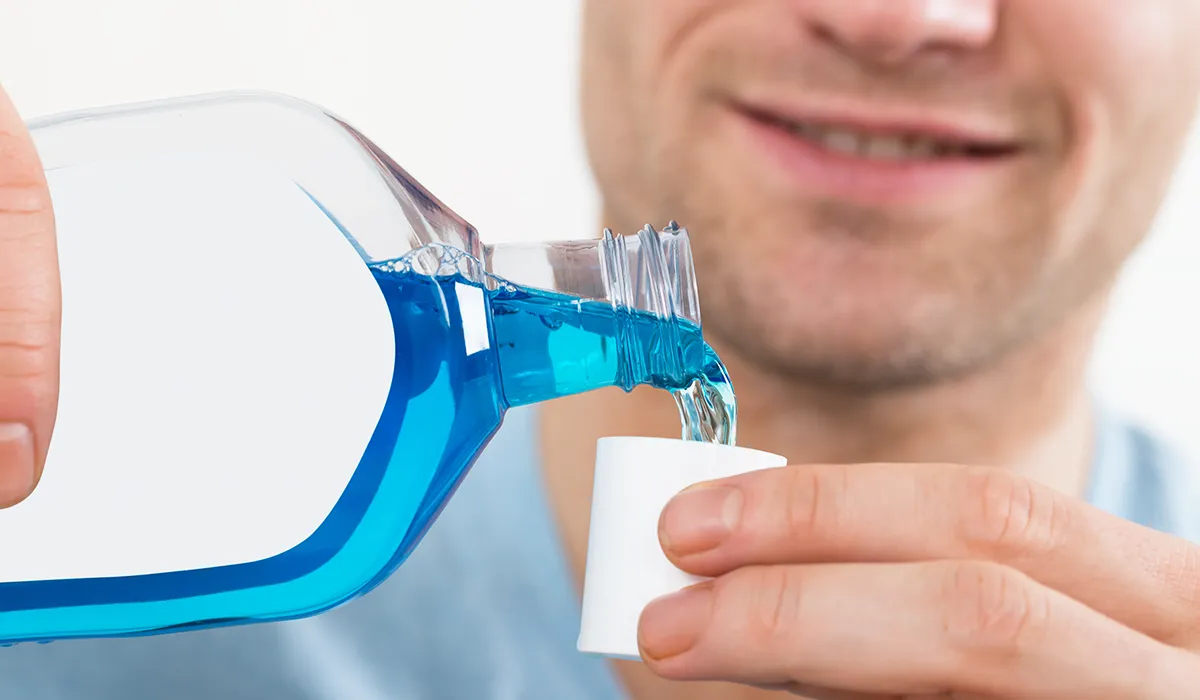That icy burst of mint after a quick swish of mouthwash can feel like a mini victory—a clean mouth, fresh breath, and a sense of confidence that you’ve done just a little extra for your teeth. It’s quick, satisfying, and often the final flourish of a good oral care routine.
Here’s the catch: mouthwash can freshen your breath, but if you rely on it alone, it could end up doing more harm than good. For something so common, it’s surprisingly misunderstood.
So, is mouthwash really essential for a healthy smile—or just a flashy rinse that masks deeper issues? Should you use it every day? Can it replace flossing? And what happens if you overdo it?
Time to clear the confusion. We’ll break down what mouthwash actually does, when it helps, when it hurts, and how to use it the right way. If you want the truth behind that minty swirl, keep reading—you might never look at your rinse the same way again.
What exactly is mouthwash?
Mouthwash, also known as oral rinse, is a liquid solution used to support daily oral hygiene. While it’s commonly associated with freshening breath, its role can go far beyond that—depending on the ingredients, it can help reduce harmful bacteria, strengthen enamel, prevent cavities, and manage gum conditions.

Mouthwashes generally fall into two broad categories:
This type focuses mainly on temporarily masking bad breath. It may leave your mouth feeling fresher and cleaner, but it doesn’t contain active ingredients that significantly improve oral health or treat underlying issues. Think of it as a short-term fix rather than a long-term solution.
These are formulated with specific active ingredients designed to target dental problems. Common variants include:
Fluoride mouthwash: Strengthens tooth enamel and helps prevent cavities by promoting remineralisation. Especially helpful for individuals prone to tooth decay, those undergoing orthodontic treatment, or with exposed root surfaces.
Antibacterial/antiseptic mouthwash: Often contains chlorhexidine, cetylpyridinium chloride, or essential oils (like eucalyptol or thymol). These reduce bacteria that contribute to plaque, gingivitis, and bad breath. Chlorhexidine, in particular, is highly effective and usually prescribed for short-term use after dental surgery or for managing advanced gum disease.
Alcohol-free mouthwash: Ideal for people with sensitive gums, dry mouth, or oral ulcers. It provides many of the same benefits without the burning sensation or potential drying effects of alcohol-based formulas.
Oxygenating mouthwash: Contains ingredients like hydrogen peroxide to help manage canker sores and promote healing by reducing oral bacteria and inflammation.
While many of these products are available over the counter, more potent formulations (such as those containing high-strength chlorhexidine) may require a prescription and should be used under the guidance of a dental professional.
What issues can mouthwash help with?
Used correctly, mouthwash can support your dental care in many ways:

1. Bad breath (halitosis): Most people reach for mouthwash to combat bad breath. While cosmetic rinses temporarily mask odour, therapeutic types fight the underlying bacteria responsible for producing foul-smelling sulphur compounds.
Gum disease (gingivitis and periodontitis): Antiseptic or antibacterial mouthwashes can help control plaque and reduce inflammation in the early stages of gum disease. In more advanced cases, your dentist may prescribe a stronger rinse, such as chlorhexidine.
Tooth decay and cavities: Fluoride mouthwashes help remineralise enamel, making teeth more resistant to decay. They are especially beneficial for people at higher risk of cavities or those undergoing orthodontic treatment.
Dry mouth (xerostomia): Alcohol-free, moisturising mouthwashes can relieve dry mouth symptoms, improve comfort, and help protect teeth when saliva is lacking.
After dental procedures: Dentists often recommend specific mouthwashes post-surgery or after tooth extractions to reduce infection risk and support healing, particularly when brushing is temporarily difficult.
How to use mouthwash the right way
Mouthwash only works well when used correctly and consistently. Here’s how to make the most of it:

- Brush and floss first: Mouthwash is more effective when it follows mechanical cleaning.
- Use the right amount: Typically 20 mL (or as indicated on the label).
- Swish for at least 30–60 seconds: Don’t rush—active ingredients need time to work.
- Avoid rinsing with water immediately after: This can dilute the effects of therapeutic mouthwash.
- Don’t eat or drink for 30 minutes, especially if using a fluoride rinse.
- Limit frequency unless directed otherwise. Once or twice a day is usually enough.
And always check the label! Some rinses are designed for daily use, while others—especially prescription types—are meant for short-term care.
Why mouthwash can be a helpful ally
When used correctly, mouthwash offers several advantages:
- Freshens breath instantly and can keep bad odour at bay throughout the day.
- Reduces bacteria in hard-to-reach areas where brushing and flossing may miss.
- Strengthens enamel with fluoride to help prevent tooth decay.
- Soothes oral tissues, especially after surgeries or dental work.
- Helps control gum disease by reducing inflammation and bacteria.
These benefits make mouthwash a helpful addition to your routine, but remember, it’s not a substitute for brushing and flossing.
When mouthwash becomes a frenemy
Not all mouthwash use is harmless. Some risks to be mindful of:
- Alcohol-based mouthwashes can cause irritation: Especially for people with sensitive mouths, ulcers, or dry mouth conditions. They may worsen discomfort or contribute to dehydration.
- Overuse may disrupt oral flora: Some antibacterial mouthwashes can kill beneficial bacteria, potentially leading to an imbalance.
- Can cause staining: Certain formulations, particularly those with chlorhexidine, may cause brown staining on teeth and tongue over time.
- False sense of security: Some people skip brushing or flossing, thinking mouthwash alone is enough. It’s not.
- Not suitable for all ages: Mouthwash should not be used by children under six due to the risk of swallowing.
As with any dental product, moderation and guidance from your dentist are essential.
Healthy mouths need more than a swish
Mouthwash can be your teeth’s good friend when used with care, intention, and consistency. It’s a powerful ally in fighting bacteria, reducing plaque, preventing decay, and keeping breath fresh. But it’s not a standalone solution. Over-reliance or misuse can turn it into a foe, potentially causing irritation, imbalance, or staining.
The key takeaway? Mouthwash is a great sidekick, but your true oral health heroes are brushing twice a day, flossing daily, and visiting your dentist regularly.
So, go ahead—swish smartly. Choose the right product for your needs, follow directions carefully, and make sure you’re keeping up with the essentials of oral hygiene. And when in doubt, ask your dentist for tailored advice. Your mouth deserves nothing less.




